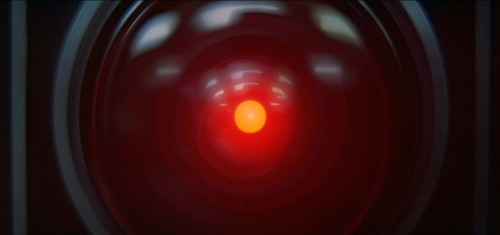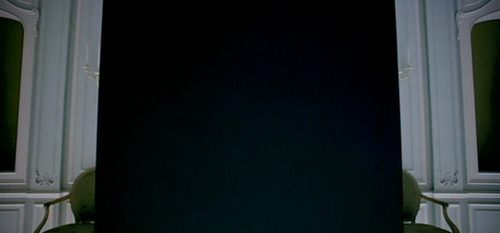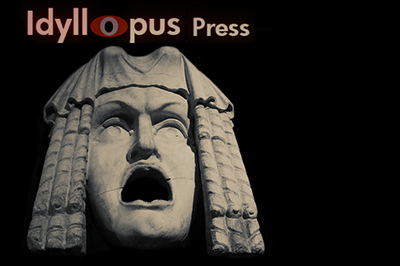
Go to TOC for this film ( (which has also a statement on purpose and manner of analysis and a disclaimer as to caveat emptor and my knowing anything authoritatively, which I do not, but I do try to not know earnestly, with some discretion, and considerable thought).
One may not have noticed that Kubrick horizontally flips the front screen projection landscape behind the monolith when it first appears in the Dawn of Man section. Below is a look at how this particular front screen projection landscape is used, the flip, and the meaning of the flip in respect of the Monolith.
A detailed description is below the images, all of which concern the front screen projections depicting the same sunrise/sunset (I say sunrise/sunset as it is seemingly used to present both sunrise and sunset during the course of its use).

The top image is shot 4 seemingly depicting sunrise. Shot 5 will show the same with the same orientation but the sun now glinting over the twin hills, which we may think of as introducing here the theme of the doubles that is in each of Kubrick's films.
We next see the same landscape in shot 43, again with the same orientation, only now it is used as a sunset image. This is the shot before the one of the panther with its evening kill, after which we have the hominids huddled together at night, anxiously listening to the panther.
Next we see the same landscape is the following morning in shot 55. This is the first shot in which the audience sees the monolith (54 was a reaction shot of one of the hominids before the audience sees the monolith). The front projection landscape is the same view as all the former ones but this time it has been flipped horizontally. Reversed. Note that in this shot from the pit we see the two distant hills that were observed in shots 4 and 5 and that they are reversed. This is the only shot in which we see these hills after shots 4 and 5.
The shot number is 55, and we do need to pay attention to this. It is expressive of the doubling that is being inferred with the horizontal flip of that landscape. If one doubts that the shot number is itself a commentary on this, read through and deliberate again when you reach shot 595 at the end of this post.
In shots 56 and 57, the hominids daring to approach the monolith, the landscape is returned to its original and common orientation.
We next have this same front screen projection landscape in shot 86. This is the first time we have returned to the pit after the appearance of the monolith. The hominids have since advanced to using bones as tools. The monolith is gone. One might think of it as having been replaced by the bones.
The last appearance of this front screen projection landscape is in shot 90, directly before the fight between the two groups of hominids at the water hole, and it is ambiguous as to whether it is sunrise or sunset. This might seem peculiar to say as it must be one or the other, the sun rising in the east and setting in the west, but we've already seen how this landscape was also used in shot 43 which seemingly depicted a sunset.
The color organization in shots 90 and 5 introduces us to the color organization we typically associate with HAL's eye.

For those who object to the horizontal flips (and other confusions of orientation) that Kubrick does being subjects for examination as thematic and commenting on story/action, being vehicles of meaning, this example of the horizontal flip, occurring with the appearance of the monolith, seems to me a concrete example of purposefulness which shouldn't be ignored.
A significant final image to supply is from the last shot of the monolith we have in the film, as the camera zooms in on it. Shot 595.

This is Kubrick talking to us purely through images. The first time we saw the monolith the landscape was flipped horizontally from its normal orientation. Here, with our last shot of the monolith, as we zoom in, the landscape is the same on both sides. Balanced. We even have a balance in the shot number which is 595–and remember, the first appearance of the monolith was in shot 55. I've proposed throughout my analyses that in all of Kubrick's films he has a kind of ground zero, a place "between", where the doubles meet, negative and positive, above and below, the thing and its inverse (though who is to say what is inversed, what is negative and what is positive). This image is a perfect expression of that proposition with the monolith as that "between".
Jan 2014. Approx 930 words or 2 single-spaced pages. A 7 minute read at 130 wpm.
Return to the top of the page.
Return to Table of Contents for "2001: A Space Odyssey" analysis
Link to the main film page for all the analyses

